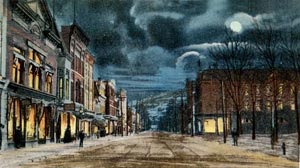
 The Day the Sun Went Out in Bradford
The Blackout - September 24, 1950
Some people thought it was the end of the world - and one man called The Bradford Era to confirm it. Some thought that it was a spectacular eclipse. Others suspected that huge guns exploding in Korea (the Korean conflict was in full swing) had caused atmospheric changes, and some feared that another atomic explosion had taken place. Whatever the cause, that afternoon when the sun in the sky over Bradford was blacked out is a day that many Bradfordians cannot forget! Government reports blamed the smoke from forest fires in Canada, but for some, even 55 years later, questions as to the cause of the blackout still remain. It was a hot September that year, 1950, and forest fires in Canada had been burning for weeks out of control. The worst fire was in Wanham, 340 miles northwest of Edmonton, where more than 300 square miles of land were blackened. In northern Alberta more than 700 firefighters had been on the line for over a week, battling nearly 30 individual forest fires that threatened small towns, farm homes, and valuable timber tracts. The darkness began in Cleveland, Ohio, about 1:00 PM and spread southward. The National Weather Bureau reported that the smoke blanket was at an altitude of 16,000 to 20,000 feet over Ohio, carried by clockwise air currents around a high-pressure area. By mid-afternoon, it extended form Chicago to Williamsport, Pennsylvania. Western Pennsylvania, Ohio and Michigan had the thickest smoke. In Pittsburgh, the Pittsburgh Pirates and the Cincinnati Reds had to play under the lights at Forbes Field. The blackout started in Bradford about 2:30 PM and continued for two hours. Birds went to roost, and streetlights came on. Everyone stood outside and looked at the sky. The local Bell Telephone office was flooded with calls relating to the blackout of the sun. Company officials estimated that 400 to 500 calls an hour were received at the local office during the two-hour blackout. Everyone had an opinion as to its cause. The most popular theory was that the Army was testing smoke screens by laying them over a huge area. Some theorized that the Russians had something to do with the situation. When told that forest fires caused the phenomenon, many were openly skeptical. They pointed out, with some justification, that it was a long way for smoke to travel. The one thing that all agreed upon was that they had never seen anything like it before. In Philadelphia, the sun turned lavender. And Philadelphia scientists were the first to discredit the reports that Canadian forest fires could have caused the change in the sun's color. All agreed that it was "unique", but they admitted that the odd coloration was probably due to peculiar formations of ice crystals in the smoke, and noted that the temperature had dropped rapidly and that the weather was cooler than normal. The Chicago Weather Bureau received reports of varied sun colors - purple, pink, yellow, and brown. At Grand Rapids, the sun turned blue and displayed a yellow aura. Skies began clearing in the rest of western Pennsylvania about 6:00 PM. The Weather Bureau estimated that the smoke cloud was moving at about 35 miles per hour, and predicted that it would move out to sea and dissipate. It did so, and eventually disappeared entirely. In Bradford, the next day, the sun came up as usual, and no after effects were seen. Still, after all these years, questions as to what "really" occurred are still in the minds of many Bradfordians who lived through "Bradford's darkest day." |